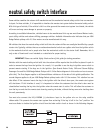
24 © 1999 Directed Electronics, Inc. Vista, CA
The system can control this type of system directly, with no additional parts. The switch will have three wires on
it, and one will test (+)12V constantly. The others will alternately pulse (+)12V when the switch is pressed to the
lock or unlock position.
If you cannot get to the switch, and you find a set of wires that pulse (+)12V alternately on lock and unlock,
you must take care to ensure that it is not a Type C direct-wire system.
Here is a test: Cut the wire which pulses (+)12V on lock, and then operate the switch to unlock.
■ If all doors unlock, the vehicle uses Type A system.
■ If you lose all door lock operation in both directions, you are operating the master switch in a Type C system.
■ If you lose all door lock operation of one or more doors, but not all motors stop operating, and other doors
still work, you have cut a wire leading directly to one or more motors. You must instead find the actual wires
leading to the switch.
Many domestically-made GM vehicles use Type A locks. However, many more GM vehicles are Type C than in pre-
vious years. The full-size pickups (1989-up), many of the S10 Blazers, the Corvette, 1995 Cavalier/Sunfire 1993
and newer, Camaro/Firebird all use Type C door locks, and cannot be controlled without a 451M! Almost all domes-
tically-built Fords are Type C. Ford builds almost no Type A systems. Chrysler builds both Type A and Type C, so
care must be taken in determining the type of door locking system.
IMPORTANT! Remember that the functions of these wires are reversed between Type A and Type B!
type A: (+) 12V pulses from the switch to the factory relays


















